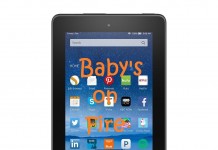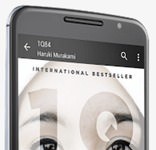 In the market for a budget reader? The market is flooding with options these says. The Kobo Reader will hit stores soon, and it’s a beautiful reader. But what else is there that is both $200 or less, and available retail? Only two in my neck of the woods: the Sony Pocket Reader and the Aluratek Libre.
In the market for a budget reader? The market is flooding with options these says. The Kobo Reader will hit stores soon, and it’s a beautiful reader. But what else is there that is both $200 or less, and available retail? Only two in my neck of the woods: the Sony Pocket Reader and the Aluratek Libre.
Of the two, the Libre is the cheaper option and when the box advertised an included 2 gb SD card with 100 books pre-loaded, I knew I had to try it out. I love my Kindle, but it doesn’t have folders or other means of grouping and organization. My must-read fiction was getting lost among magazine back issues, personal documents and other numerous files.WHAT THE LIBRE INCLUDES
The memory card was not the only goodie in the Libre box. It came with a USB cord for charging and syncing, a power card for charging directly in the wall, a set of headphones to use with the MP3 feature and a little pouch to carry it around with you—important since this is not a brand with third-party extras like M-Edge cases available. I’ve heard that that some cases designed for the Sony Pocket Reader will fit the Libre, but have not tried this myself.
The Libre supports several popular formats including TXT, RTF, FB2, non-DRM PRC and MOBI and all forms of epub and PDF, encrypted or otherwise. Although the hardware is the same as the Ectaco Jetbook, which Calibre supports, I could not get Calibre to recognize the Libre, so I used the save to disk function and put all the files directly onto the card.
I was worried at first about not having a reader that Calibre would recognize, but I came to appreciate how speedy it was to transfer onto the card without having to worry about plugging in the reader and mounting/unmounting it every time I had to add some files.
BASIC OPERATION
The Libre uses an e-ink competitor called ‘epaper’ which is as comfortable to read on, but not quite as clear (larger-sized font choices look like a dot matrix printout from the pre-inkjet printer days) and not quite as battery-efficient. My battery lasted about three days before suddenly dropping from three bars to one when I turned it on after a break.
The screen was comfortable to read on and the files were easy to access. The directional keypad is used to select a file, move through multiple screens of options or turn the pages in a book. Two square buttons on the left side can also be used to turn the pages. In other navigational notes, a small ‘back’ button under the directional pad can return the user to a previous menu or folder and a button beside it can flip the screen to a landscape orientation.
In an odd user interface glitch, the page-turning arrows on the right side don’t work when you’re using an epub file. You have to reach over the square buttons on the left side, or to the frivolous slider bar that runs up the left outer edge. I didn’t like having to reach across and it affected my ability to hold and read with one hand. I am not sure why the arrow buttons were disabled for epub files and what purpose that would serve, so this annoyance irked me all the more.
Among the choices when the device is first turned on is a ‘help’ command that accesses a basic PDF manual. It was handy having this right on the device; the Sony 505 did not have one, and the Kindle guide is too easy to lose in the sea of folder-less, tag-less files. Having this be a menu option as opposed to an ebook file was a nice touch.
READING ON THE DEVICE
The device is not quite as sleek and slick as others I have tried. It is a little bottom-heavy, which makes it somewhat awkward to hold in one hand for long periods. Once I got used to holding it and working the controls, it was fine. It is tiny in my bag, compared to the Kindle, and its little slip sleeve more than does the job. I have heard that some of the after-market cases for the Sony Pocket Reader will fit the Libre too but I did not test this.
There were 100 text files from Project Gutenberg pre-loaded onto the reader. These all displayed fine on the reader. The screen could be rotated and the font size could be changed from among several options. The plain text files looked fine and were easy to read on the Libre without further work to convert or translate.
In my reading so far, I have stuck mostly to mobipocket files. The issue with the page-turn buttons and epub files was a deal-breaker and I also found the epub font not as attractive as the default system font for mobi. And I had them already converted for the Kindle so using these files did not require any further fiddling.
One advantage this device has over readers like the Sony is its lack of need for software. If you plan to read text files or other unencrypted formats, this is a huge plus. My Sony supported unencrypted files but if I tried to use it with a computer which didn’t have the software, it would try to download it. The Kobo supports unencrypted files, but only epub—so anything from Gutenberg or elsewhere has to be converted first. And of course secure ePub can only be transferred from an authorized computer.This is the first device I have used where I could just pop a media card into the computer at work and get new content onto it right away.
MY VERDICT
This is a solid bare-bones reader. I like that it doesn’t need any software. I can add text files and multiformat Fictionwise files on the fly, unlike other readers I’ve tried. The font choices are a little thin and don’t look great at high magnification, and it doesn’t always keep your settings, which can get tiresome. I’d like an ability to delete files without hooking up to the computer, but that is not a deal-breaker for me.
The ability to group my stuff more than makes up for these tiny quibbles though. I have over 900 ebooks. Some of them are novels I’ll read straight through and cherish, but others are fairly disposable content like fanfiction and short story magazines. It’s so nice to have a second reader where I can keep that stuff without it cluttering up my Kindle. It’s also nice to have a smaller reading option. I love my Kindle but there are times when it’s a little much to carry around and I’d like a smaller option.
I paid $169 Canadian for this and to me, that is an acceptable price point for this type of device. Both the Kobo and Sony are going for a little less or a little more. But some 5-inch readers are going for as much as $250 and at that price point, I wouldn’t have gotten it.


































“I love my Kindle, but it doesn’t have folders or other means of grouping and organization. My must-read fiction was getting lost among magazine back issues, personal documents and other numerous files.”
Have you read the latest Kindle news? Kindle 2 and DX both are getting support for collections that you can organize your books with…should roll out by the end of May!
I have the Jetbook, which is the same basic unit (Thought the firmware might be different). Here are some basic points.
ePaper is really nothing more than a good old reflexive LCD screen similar to what most of us are use to from old fashioned calculators. It works well, but burns power whenever the screen is displaying anything (As opposed to E-ink which only uses power on page refreshes). There are two big advantages (At least as far as I am concerned): 1. Page refresh is nearly instantaneous — far faster than e-Ink. 2. It doesn’t have a glass substrate like e-ink, which I believe makes it somewhat more durable.
I agree the folder feature is really nice. I can essentially organize all my books on my computer first, and then just copy the whole directory tree over. I admit, this is not something most people would do, but it is nice for me :).
There is a method to delete a book directly from the Libre Pro. From the book list, select the book you want to delete, press the upper left (function) button. One of the selections on the menu list is delete book.
Thank you, Joyslin! That is a handy tip.
Today, I have been reading from a borrowed Aluratek Libre Pro and really like the device. The Libre is lightweight, easy-to-hold, and allows quick and easy book navigation with the page turning buttons (however, I’m not too fond of the slider bar along the left side). Though the screen is small, it’s still comfortable to read, especially in landscape mode and with mid-size fonts. As you mention in your article, adding books is a breeze using the SD card or USB connection. The reader even does a decent job of re-flowing PDF documents! For the low price, I give it a thumbs up!
Thanks for the thorough and very interesting review.
For people who want bare-bones (no Search, inline-dictionary, highlighting, notes, etc, no mp3s or audible/audio) and who want not only an inexpensive reader but one that is able to use the library for new e-books, I’ve been recommending Kobo since it’s $150 and can do the library thing.
Really liking the beautiful results from huge fonts on e-ink (Kindle/Sony/Nook/Kobo) made me pause when reading about the dot-matrix-like look on the Aluratek Libre Pro with the large fonts.
(I guess only ‘Deluxe’ could follow ‘Pro’ ?.)
As others have said, Amazon now has Collections and they’ve done a good job on it, per word from the subset of people who have gotten the software updates early as a sort of beta group which was not self-selected. I’ve added a guide to using that feature and am impressed with what Amazon designed.
Since Amazon still isn’t supporting even non-DRM’d ePub I may wind up getting a Kobo (if they have a sales event on it) so that I can have one that can be used with library e-books even if I’d miss the dictionary and search capabilities.
Thanks for the review. FYI – just saw this at an SF Bay area Fry’s on a $79 sale. Wonder how this price point affects volume. If the ePaper LCD devices can be put out with this price tag, we should see more of them than eInk ones.
In my opinion this device is not that far out of the league with the likes of the Sony reader. I am not interested in the store/purchase capability, so that does color my perspective.) You’d probably have to reach to an iPad to get to an entirely different level of device (also at an entirely different level of price. 🙂
I purchased a Libre at Costco for $99 and love it. I understand it is bare bones but it does everything so far I want and found it much easier to read than I expected. If it had been even $200 I wasn’t ready to try an electronic reader – now I can hardly wait to go on a trip and have a whole library to take with me.